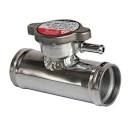Selidster
Senior Member
- Joined
- Mar 21, 2018
- Messages
- 106
- Location
- USA
- Vessel Name
- Lemonade
- Vessel Make
- Kadey Krogen 42 - 016
I thought my Lehman 120 overheated today. It always sits at 162 degrees while underway or idling. Comes up to temp and stays there. Today after changing fuel filters and running it afterwards the temp jumped to 190. I immediately shut it off. My manual says it should run 175 to 190 but 195 is optimum. I'm questioning my guage a bit now. What temp are other Lehman's running?


